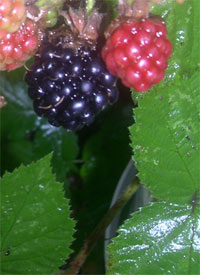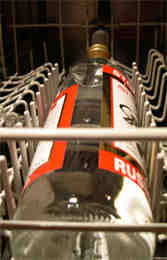Blackberry and apple jam recipe
Posted by Fiona Nevile in Jam Jelly and Preserves | 237 comments It was Anne Mary that pointed out that apple and blackberry jam would be full of blackberry pips.
It was Anne Mary that pointed out that apple and blackberry jam would be full of blackberry pips.
“They’d get stuck in your teeth and drive you mad. Stick to bramble jelly.”
I love jelly. We make loads of jelly every year. More often than not it is used as a base for a sauce rather than dolloped on a plate of roast lamb or pork.
Imagine my delight when I found this recipe for Blackberry and Apple Jam in my aunt’s ancient handwritten cookbook. As it is sieved there are no seeds and the jam is delicious, spread on hot buttered toast in the morning.
Blackberry and Apple Jam recipe
Ingredients:
- 1k (roughly 2lb) of blackberries
- 350g (12ozs) of apples (eating apples, windfalls are fine)
- Water
- White granulated sugar
Method:
- Core and roughly chop the apples (skin on).
- Put the apples, cores and blackberries in a large preservaing pan or large heavy bottomed saucepan. Add just enough water to cover and simmer until soft.
- Sieve the softened fruit and weigh the sieved pulp (discard the skins and seeds left in the sieve). Add 450g (1lb) of sugar for each 450g (1lb) of sieved pulp.
- Put sieved pulp and sugar into a large heavy bottomed saucepan (or preserving pan) and heat very gently until the sugar has dissolved.
- Bring the jam to the boil and continue to boil very rapidly for about 8-10 minutes until the jam reaches setting point. (What is setting point? See tricks and tips below).
- When the jam has set, carefully pour into warm, sterilised jars, using a ladle or small jug (How to sterilise jars? See tricks and tips below)
- Cover the jars with tight fitting screw-top lids, or waxed disks and cellophane pot covers (waxed disks, wax facing downwards and plastic covers secured with plastic bands).
- Label when cold and store in a cool, dark place, away from damp.
Tricks and Tips:
- Jam “set” or “setting point”:
Getting the right set can be tricky. I have tried using a jam thermometer but find it easier to use the following method. Before you start to make the jam, put a couple of plates in the fridge so that the warm jam can be drizzled onto a cold plate (when we make jam we often forget to return the plate to the fridge between tests, using two plates means that you have a spare cold plate). Return the plate to the fridge to cool for approx two minutes. It has set when you run your finger through it and leave a crinkly track mark. If after two minutes the cooled jam is too liquid, continue to boil the jam, testing it every few minutes until you have the right set. The jam is far more delicious if it is slightly runny. - Sterilising the jars:
We collect jars all year round for our jelly, chutney and jam making sessions. I try to soak off labels and store the clean jars and metal plastic coated screw-top lids in an accessible place. The sterilising method that we used is simple. Just before making the jam, I quickly wash and rinse the jars and place them upside down in a cold oven. Set the temperature to 160c/140c for fan assisted. When the oven has reached the right temperature I turn off the heat. The jars will stay warm for quite a while. I only use plastic lined lids for preserves as the all-metal lids can go rusty. I boil these for five minutes in water to sterilise them. If I use Le Parfait jars, I do the same with the rubber rings.
Leave a reply






Found this recipe by accident,but have just used it for the 3rd time with hedgerow blackberries(free) windfall apples (free) so, I had to buy the sugar but for a couple of pounds I made 9Lb of delicious jam thankyou.
We live in Northwest London and after disturbances and riots of recent days, spent a relaxing afternoon picking blackberries by the canal. We have just made 7 lovely jars of jam and has given us enormous pleasure!Who nees latest trainers; here’s to simple pleasures! Thanks for recipe!
Ooooh, I’ve just stumbled upon your website and I LOVE IT! I’ve a freezer full of last year’s blackberries and apples so shall give this a go tomorrow! Thanks!
Jaki, use the pulp and liquid but, not the seeds pete.
Just the liquid!
Good luck, it’s yummy,
Trish
Help please! I am literally making this jam right now and I want to know if I use the liquid or just the pulp??
Anybody looking at this now a reply would be gratefully received
I have just made this jam this afternoon, with the blackberries from my garden. It’s worked fantastically well, and as it it the first time I have ever made jam, I’m very chuffed. I didn’t use a
sieve, as I used my vitamix, which blends purées very finely, and it’s worked just fine.
Thanks you for fab recipe
we have made jam like this for years, its just about the most popular around this neck of the woods.
To make it easier to sieve the fruit pulp and increase the yield put the pulp into a blender and give it a good thrashing for a minute or two, you will find not only does the pulp go through the sieve easier but the yield is up by 10%. It only took me 28 years to figure this one out but, then of course I am a male.
There seems to be some confusion above about preserving sugar. Preserving sugar is 100% sugar and contains no pectin so I can’t see any reason why the setting point would be reached any quicker with it (as reported by others).
Silverspoon, a company making preserving sugar say, “it’s perfect for making marmalades, jams and preserves using fruits that are naturally high in pectin”, this is the opposite from what other people have suggested here.
Made this jam yesterday absolutly yum loving the no seeds in it